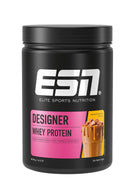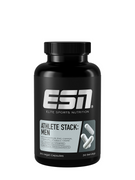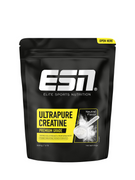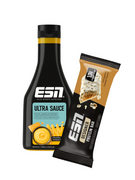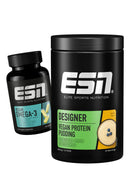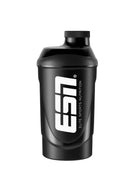Was ist Whey Eiweiß?
Beim Whey Protein handelt es sich eine besondere Proteinart, die aus Milch beziehungsweise aus Molke gewonnen wird, was wiederum einige Vor- und Nachteile in sich birgt – mehr dazu im Verlauf dieses Artikels. Molke selbst besteht zu gut 94 Prozent aus Wasser, zu rund 4 Prozent aus Laktose und zu einem Prozent aus Molkeeiweiß. Zudem enthält Molke wichtige Mikronährstoffe wie Kalzium, Kalium, Phosphor sowie die Vitamine B1, B2 und B6, die sich bei hochwertigen Produkten auch zu großen Teilen im Endprodukt wiederfinden.
Molkeeiweiß ist ein sehr hochwertiges Protein, das nicht nur sehr schnell in die Blutbahn aufgenommen wird, sondern durch den Organismus auch sehr effizient in körpereigenes Protein umgewandelt werden kann. Diese vorteilhaften Eigenschaften hat das Molkeprotein (wie auch viele andereProteine) in erster Linie seiner Eigenschaft als komplettes Protein zu verdanken. Als komplettes Protein bezeichnet man alle Eiweiße, die über alle neun essentiellen Aminosäuren verfügen, die für die Proteinsynthese im Organismus unabdingbar sind. Zwar sind auch die sogenannten nicht-essentiellen Aminosäuren nicht minder wichtig, doch müssen diese, anders als die essentiellen, nicht für Muskelaufbautraining supplementiert werden.
Essentielle Aminosäuren:
- L-Histidin
- L-Isoleucin
- L-Leucin
- L-Lysin
- L-Methionin
- L-Phenylalanin
- L-Threonin
- L-Tryptophan
- L-Valin
Mit Hilfe dieser Aminosäuren ist der Körper dazu in der Lage, manche andere Aminosäuren selbst herzustellen, sofern diese nicht in ausreichender Menge überdie Nahrung zugeführt werden. Zudem zeichnet sich das Whey Protein durch seinenhohen Anteil an verzweigtkettigen Aminosäuren, den sogenannten BCAAs, aus, die vomOrganismus besonders schnell verwertet werden können, da sie direkt in dieMuskulatur gelangen und nicht erst über die Leber verstoffwechselt werden müssen.Das gilt besonders für das Leucin, welches der Trigger für dieMuskelproteinsynthese ist.
Welche Arten von Molkeprotein gibt es?
Whey Protein kann mit Hilfe unterschiedlicher Verfahren hergestellt werden, was wiederum dazu führt, dass sich die daraus resultierenden Varianten hinsichtlich ihrer Nährstoffzusammensetzung voneinander unterscheiden. Damit ergeben sich auch jeweils individuelle Einsatzgebiete. Die wichtigsten möchten wir dir vorstellen:
Konzentrat
Whey Protein Konzentrat, auch als WPC abgekürzt, ist die Standardvariante des Molkeproteins, das mit Hilfe eines einfachen Filtrationsverfahrens gewonnen wird. Durch den vergleichsweise geringen Herstellungsaufwand handelt es sich um die günstigste Produktvariante. Produkte dieser Kategorie zeichnen sich durch einen Proteinanteil aus, der sich zwischen 70 und 80 Prozent bewegt.
Darunter befinden sich etwa 50 Prozent essentielle Aminosäuren sowie 10 Prozent BCAAs. Im Gegenzug sind der Fett- und der Kohlenhydratgehalt relativ hoch. Da es sich bei den Kohlenhydraten um Milchzucker (Laktose) handelt, ist Whey-Protein-Konzentrat nicht für Sportler mit einer Laktoseintoleranz geeignet.

Isolat
Deutlich aufwändiger fällt die Herstellung bei Molkeprotein-Isolat aus, das entweder durch ein Mikrofiltrations- oder ein Ionenaustauschverfahren hergestellt wird. Dieser Aufwand, der sich auch im Preis niederschlägt, lohnt sich allerdings, da somit ein deutlich höherer Proteinanteil von bis zu 95 Prozent erzielt werden kann.
Während beim Ionenaustauschverfahren spezielle Salze angewendet werden, um diesen hohen Proteinanteil zu generieren, ist dies beim deutlich schonenderen Mikrofiltrationsverfahren nicht der Fall. Damit fällt die Qualität bei derartigen Produkten nochmals ein wenig höher aus. Aus dem hohen Proteingehalt ergibt sich im Umkehrschluss ein sehr geringer Fett- und Kohlenhydratanteil von nur knapp einem Prozent. Damit eignen sich Isolate auch für Allergiker oder Sportler, die eine sehr strenge Diät fahren.
Hydrolysat
Der Name dieser Whey-Variante stammt vom Herstellungsverfahren. Bei der sogenannten Hydrolyse werden die in der Molke enthaltenen Proteinketten aufgespalten. Dadurch kann für eine sehr gute Aufnahmefähigkeit gesorgt werden, da die weitere Zersetzung in Aminosäuren erleichtert wird.
Der Nachteil dieses an sich sehr hochwertigen Whey-Produkts ist der leicht bittere Geschmack, weshalb das Hydrolysat nur selten in Reinform als Pulver zum Mischen von Shakes verkauft wird. Deutlich häufiger kommt es daher als Beimischung in Whey-Produkten und Mehrkomponentenproteinen oder bei der Herstellung von Eiweißtabletten zur Anwendung.
Für wen eignet sich Molkeprotein?
Whey Eiweiß eignet sich im Grunde genommen für alle Sportler, die regelmäßig und intensiv trainieren. Das betrifft sowohl Athleten, die Muskeln aufbauen möchten als auch solche, die ihren Körperfettanteil reduzieren oder schlicht Ausdauersport betreiben wollen. Molkeprotein leistet einen wertvollen Beitrag zu einer proteinreichen Ernährung, da es einerseits dazu beiträgt, den deutlich erhöhten Eiweißbedarf zu decken und andererseits beispielsweise nach dem Training sicherstellt, dass dem Organismusdirekt viele notwendigen Bausteine für die Muskelregeneration zur Verfügung stehen. Weitere Vorteile sind die mittlerweile sehr fortgeschrittene geschmackliche Abwechslung, die gute Verdaulichkeit und die sofortige Verfügbarkeit nach dem Training, da es gut transportabel ist.
Hat Whey Protein Nebenwirkungen?
Da es sich bei Molkeprotein um nichts weiter als ein Lebensmittel handelt, wenn auch ein hochkonzentriertes, sind kaum Nebenwirkungen zu erwarten. Eine Ausnahme bietet sich hingegen bei Allergikern, die auf Laktose reagieren. Wie bereits angesprochen kann dieses Problem leicht mit Hilfe von Whey-Protein-Isolat gelöst werden. Da sich der Körper zunächst an den hohen Eiweißkonsum gewöhnen muss, kann es vor allem zu Beginn der Einnahme zu leichteren Beschwerden wie Blähungen oder Übelkeit kommen. Diese Symptome legen sich in der Regel aber bereits nach kurzer Zeit wieder vollständig. Ansonsten gilt wie bei jedem Lebensmittel: Maßloses Übertreiben ist nie die Lösung. Im Falle von Whey kann eine vielfache Dosierung bei nüchternem Magen etwa zu Durchfall führen.
Wie sollte Whey Eiweiß eingenommen werden?
Molkeprotein wird idealerweise in Form eines Shakes eingenommen, wobei die Dosierung abhängig vom Körpergewicht ist. Damit ist garantiert, dass dem Organismus mittelfristig ausreichend Eiweiß zur Verwertung zur Verfügung steht. Eine Menge von ca. 0,5 Gramm pro Kilogramm Körpergewicht an Eiweißpulver pro Shake ist in dieser Hinsicht ausreichend, wobei man bei etwa 40 Gramm Proteinzufuhr pro Shake auch deckeln kann. Viele Whey-Protein-Geschmacksrichtungen schmecken in Wasser aufgelöst ziemlich gut, wobei einige Sportler eine Mischung mit Milch bevorzugen. Eine Milchmischung enthält zwar deutlich mehr Kalorien, dafür aufgrund des natürlichen Eiweißgehalts der Milch auch etwas mehr Proteine. Das Fett in der Milch beeinflusst die Aufnahmefähigkeit übrigens nur minimal und stellt daher kein Problem dar. Alternativ kann Whey Eiweiß auch hervorragend zum Backen von Pfannkuchen, Keksen und Proteinmuffins verwendet werden. Vielfältige Geschmacksrichtungen machen diese Art der Verwendung besonders interessant.
Um den Körper bestmöglich beim Muskelaufbau beziehungsweise Muskelerhalt zu unterstützen, sollte Whey Protein vor allem unmittelbar nach dem Training in Form eines Post-Workout-Shakes eingenommen werden. Idealerweise geschieht dies zusammen mit gut einem Gramm Maltodextrin pro Kilogramm Körpergewicht. Diese schnell verdaulichen Kohlenhydrate helfen dabei, die Muskelglykogenspeicher aufzufüllen und dienen zeitgleich als Transportmatrix, sodass die Aminosäuren schneller in die Muskulatur gelangen. Ein Shake unmittelbar nach dem Aufstehen sorgt zudem für einen schnellen Übergang von katabolen Stoffwechselprozessen hin zu anabolen Stoffwechselprozessen. Molkeprotein fungiert daher auch als Muskelschutz.
Die Einnahme ist jedoch nicht nur als Post-Workout-Shake effektiv, sondern hat viele gute Einsatzzeiten. Diese Tabelle gibt dir eine Orientierung der Eignung von Whey-Proteinen im Vergleich zu anderen Proteinen für deinen Trainingsalltag:
| ZEITPUNKT | WHEY | WHEY-ISOLAT | MICELLAR CASEIN | MKP | SOJA-ISOLAT |
|---|---|---|---|---|---|
| Vor dem Training | ++ | ++ | - | o | + |
| Nach dem Training | ++ | ++ | - | o | + |
| Frühstück | ++ | + | o | + | + |
| Vor dem Schlafen | + | + | ++ | + | + |
| Schluck zwischendurch | + | + | + | + | + |
| Abwechslung | ++ | ++ | ++ | ++ | ++ |
| Lactose-Intoleranz | + | ++ | + | o | ++ |
| Veganer | - | - | - | - | ++ |
| In einer Diät | + | ++ | ++ | + | + |
Erläuterung:++ sehr geeignet |+ geeignet |o weniger geeignet |- nicht geeignet
Wie immer gilt: Auch das beste Supplement kann eine ausgewogene Ernährung nicht ersetzen.
Woher bekomme ich Whey-Proteine?
Falls dir dieser Artikel hilfreich war, würden wir uns freuen, wenn du bei uns fündig wirst.

Vegane Alternativen
Wer einen veganen Lebensstil pflegt, wird Molkeproteine meiden. Die einzige ernsthafte vegane Alternative zum Whey sind Soja-Proteine. Es besitzt ähnlich gute Eigenschaften, was die Dauer von der Einnahme bis zum Eintritt der Aminosäuren ins Blut angeht. Größter Nachteil ist der Mangel an Methionin, welcher gezielt ausgeglichen werden sollte, etwa durch den Verzehr von Nüssen, bspw. Paranüssen. Der Verzehr muss nicht gleichzeitig erfolgen, da die Proteine der Nüsse sowieso verzögert ankommen.
Fazit
Whey Eiweiß ist ein ideales Nahrungsergänzungsmittel, das sowohl Einsteigern als auch Profis dabei hilft, ihre Ziele zu erreichen. Wenn man also vor die Wahl gestellt würde, nur ein einziges Supplement mit auf eine einsame Insel nehmen zu dürfen, wäre dies in jedem Fall ein hochwertiges Whey Protein, am besten natürlich in der bevorzugten Geschmacksrichtung.
